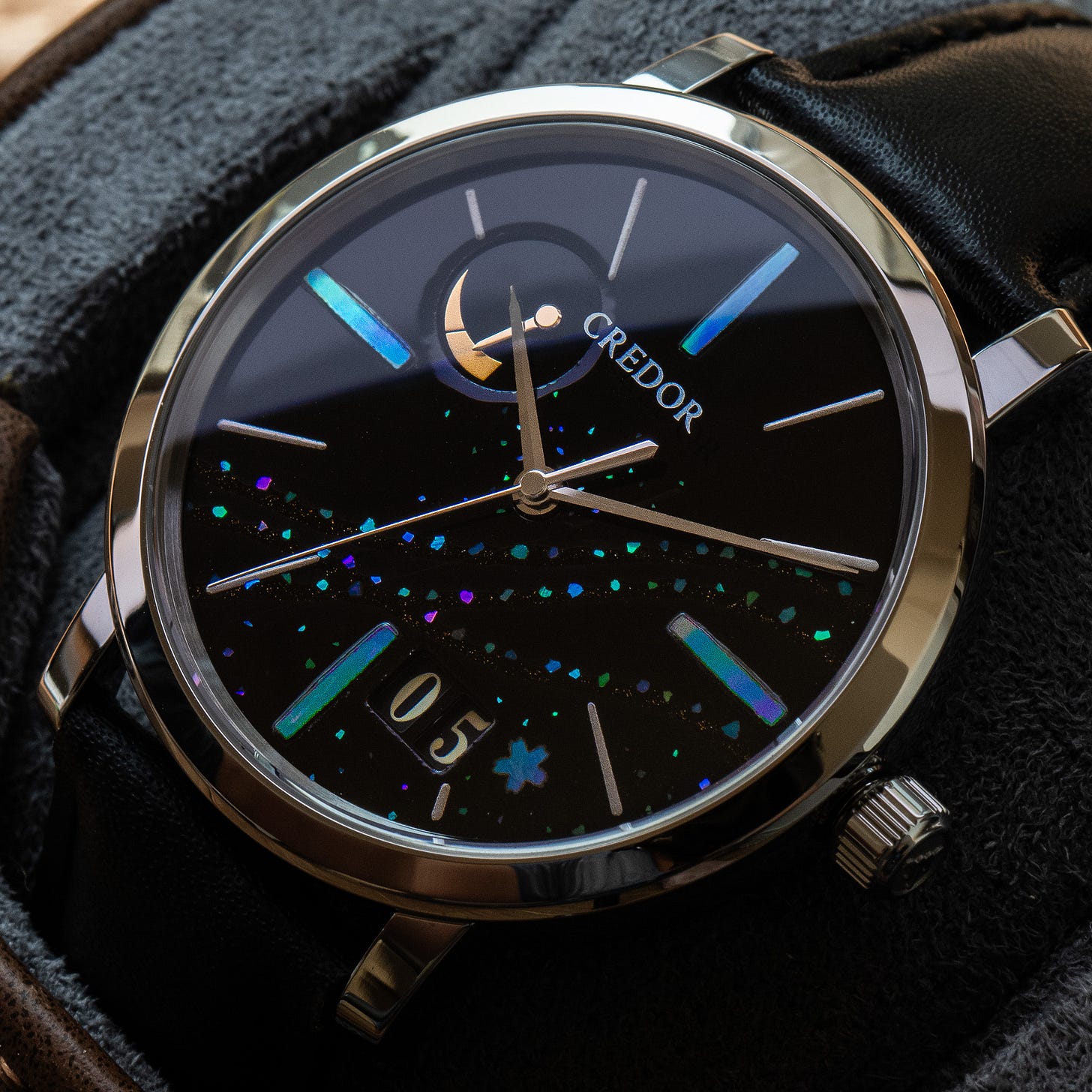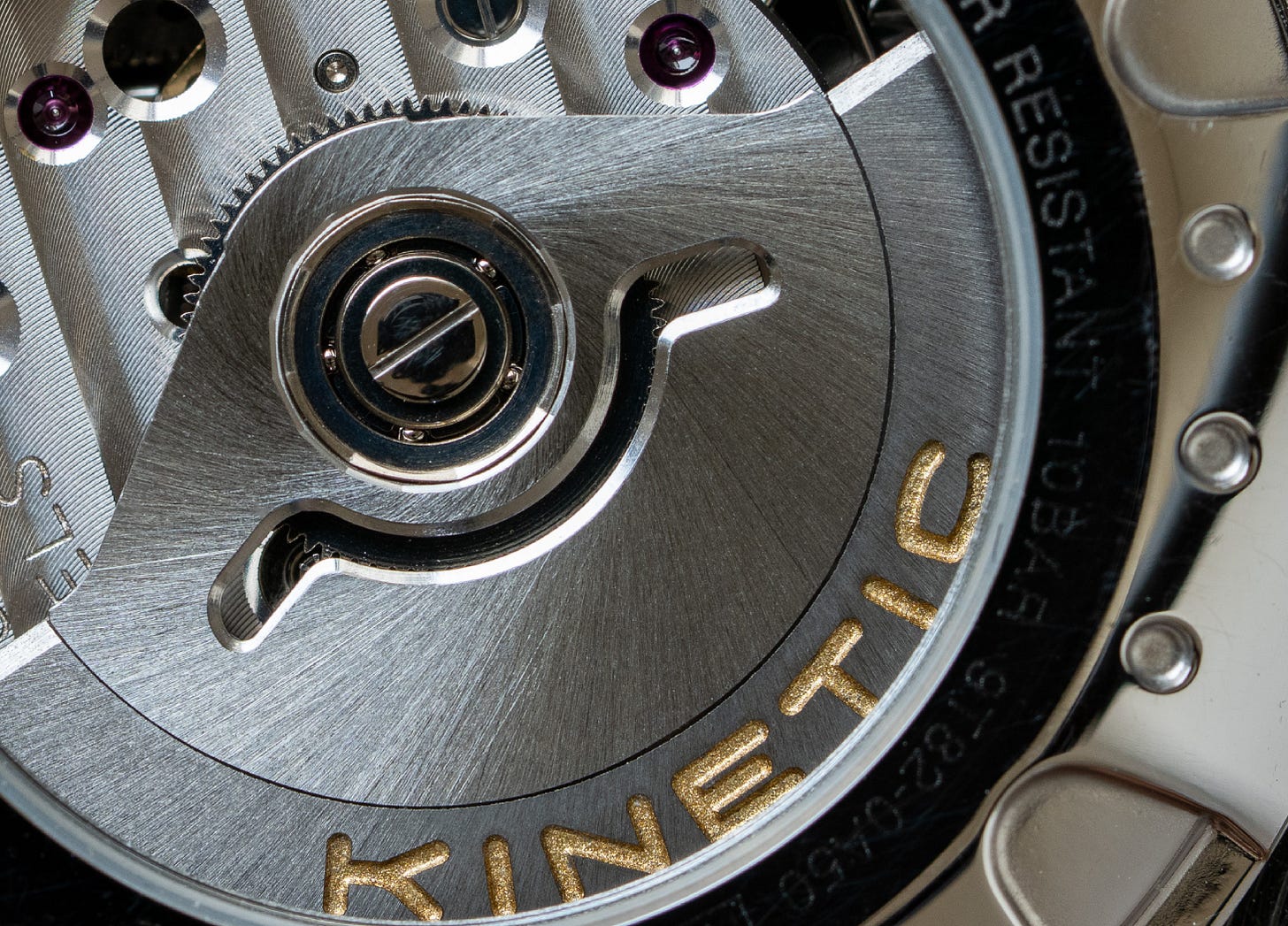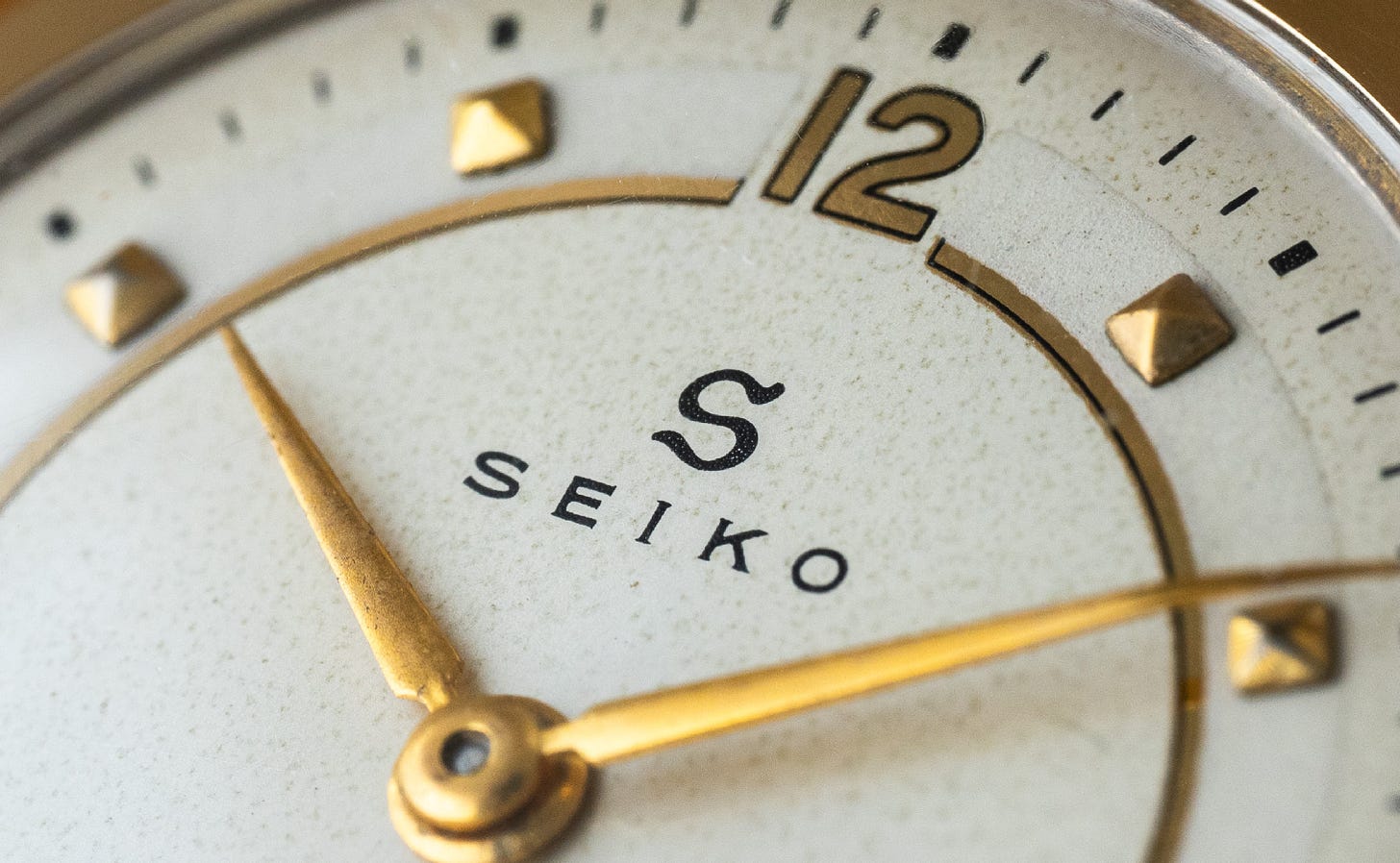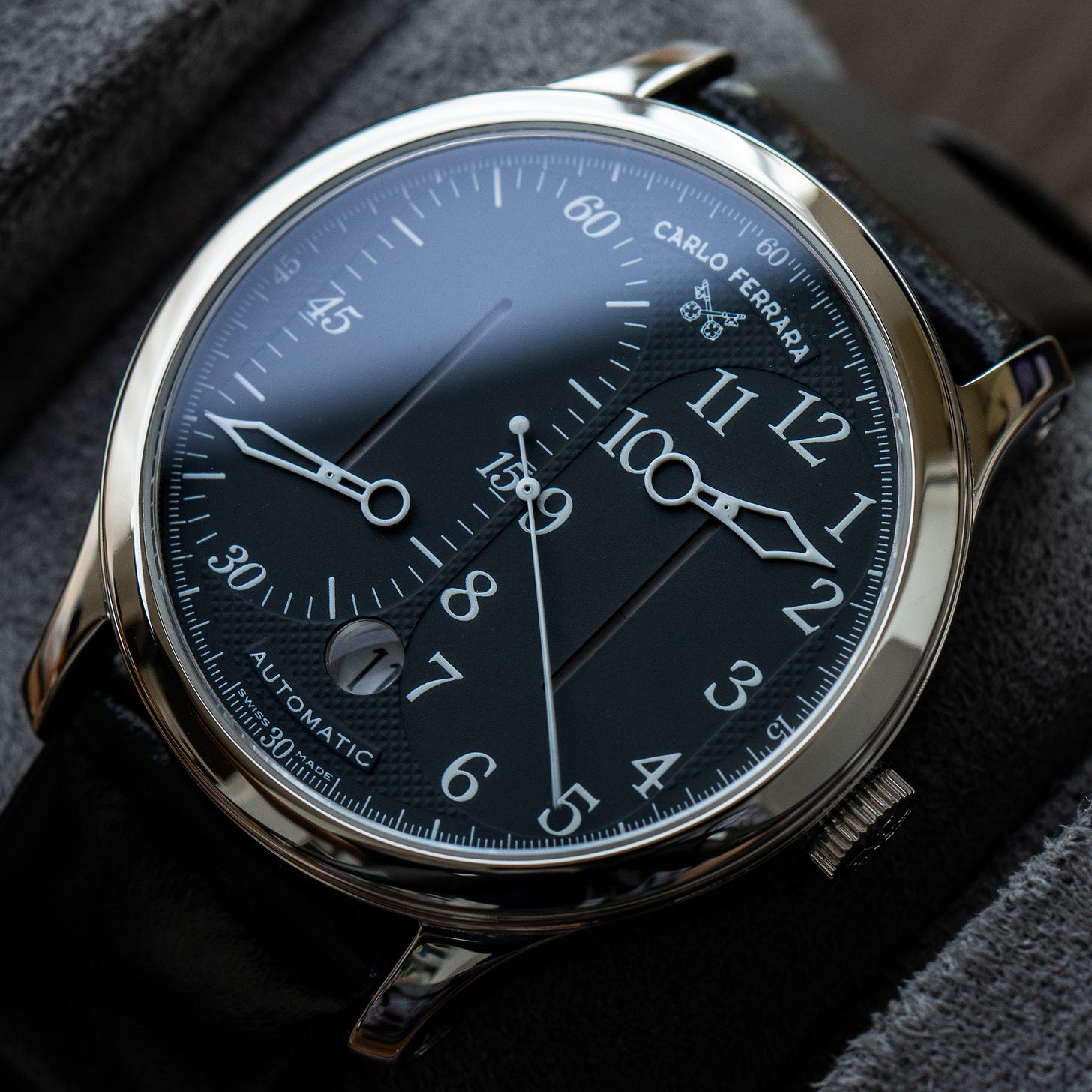The Precursor
Not only do I have some unusual pieces to share this week, but I’m also debuting a new part of the newsletter:
It’s Not Japanese, But It’s Pretty Neat…
I won’t pretend I’m great at naming things - but what the title lacks in brevity or wit, it makes up for in accuracy.
Japan is rightly celebrated for its bold and unconventional watch design, and every so often I come across something that, while not Japanese in origin, certainly channels the same spirit. This week’s example? A dancing hands regulator from a Roman master who spent six years developing his signature complication.
Credor “Sakura Fubuki” Raden GCLP989 (LE 120)
Seiko don’t use Mother of Pearl often, so expect something special when they do. I’ve been revealing the Credor Big Dates in what I believe to be their order of punchiness, and we’ve almost reached the peak. Believe it or not, I have one final Big Date up my sleeve that surpasses the cost of this Sakura Fubuki - but I don’t think anything could best this watch in terms of beauty.
Raden is a traditional Japanese decorative technique in which hand-cut slivers of mother-of-pearl are inlaid into lacquer. You won’t be surprised to learn, given Seiko’s love of artisanal craftsmanship, that this isn’t a modern artistic flourish - examples of Japanese Raden lacquerware date back to the 8th century.
Seiko partnered with Yamada Heiando, a 106-year-old Tokyo-based lacquerware atelier, to produce all 120 dials by hand. While any lacquer could technically be used for Raden, Yamada Heiando wisely opted for urushi - the famously deep, jet-black lacquer that offers maximum contrast against the iridescent inlays. The result is nothing short of extraordinary.
The theme is simple but deeply symbolic. Sakura Fubuki translates to “storm of cherry blossoms,” and the dial is filled with delicate sakura petals dancing across a moonlit sky, with a single cherry blossom floating near the Big Date window.
At first glance, it’s simply a beautiful scene - but as you might remember from a previous newsletter, the cherry blossom is frequently used in Japan as a poetic reminder of life’s fragility. Like the blossom itself, human life can bloom brilliantly and perish suddenly.
If you wanted to flex that English Literature minor you did in College, you could go one step further and suggest the position of the only in-tact cherry blossom is no coincidence. Positioned beside the date window, it becomes a quiet reminder that any given day could be the moment your petals join the storm.
The value of time, and making every second count, has been an overarching theme across various modern Credor collections, and the GCLP989 continues that tradition with subtle grace.
As much as I’d like to, I won’t be discussing the movement itself today as I’ve gone into detailed about Seiko’s only Spring Drive Big Date movement before. But it’s a perfect pairing - a unique movement for an exceptional dial. Everything about this watch is carefully considered and flawlessly executed.
We all know the “photos don’t do it justice” cliché, but hear me out before you roll your eyes. For example, had you noticed the Credor logo? It isn’t printed on the dial but is instead painted onto the underside of the sapphire crystal. You’ll have more fun casting little Credor shadows onto the dial than you could possibly imagine.
And then there’s the raden. Depending on your angle and the lighting, the mother-of-pearl fragments flash with silvery shades of every green, pink, purple and blue hue. It’s a wrist-rolling dream.
The Credor GCLP989 is now available to buy on our website
In great condition. Just serviced by Credor in Japan (one year manufacturer’s warranty). No major markings of any significance. Non-original Credor box, and Service Papers. On an aftermarket strap.
Seiko SBCG001 Kinetic (LE 1000)
It was recently revealed to be the US head of Seiko’s favourite release. Designed by Shinji Sato, who joined Seiko in 1983 and continues to create watches for the brand to this day, the SBCG001 Chronograph avoids a central dial altogether. Instead, it opts for four sub-dials - five, if you’re generous enough to count the date window!
Sato took his inspiration from aircraft cockpit instrumentation. Often described as retro-futuristic, the design has always struck me as something else entirely. There’s a charmingly antiquated quality to it - part WWII pilot’s watch, due to its stark contrasts and simple legibility, and part Otsuka Lotec, with a mechanically inspired, industrial aesthetic.
The SBCG001 first saw a limited release in Japan, with 1,000 pieces engraved on their casebacks (the one offered here is number 0941/1000). The Kinetics quickly proved more popular than anticipated, and subsequent versions were released internationally without individual numbering - suggesting Seiko didn’t expect just how much this experimental layout would resonate beyond Japan.
The movement is Seiko innovation - a hybrid between electric and kinetic energy. Often referred to by Seiko as the brand’s “third movement type” (after mechanical and quartz), it functions like an automatic in that it uses a rotor to generate energy. However, instead of winding a mainspring, that energy is stored in a rechargeable long-life capacitor.
You get the accuracy of quartz, with the longevity of an automatic, as the capacitors only need to be replaced every ~15 years - far less frequently than the typical 1–2-year battery change required by standard quartz watches.
Its similarity to the Spring Drive is no coincidence. Both the original Spring Drive and the SBCG001 were released in 1999 and both hand-assembled at Grand Seiko’s Shinshu Watch Studio. In fact, if you send your SBCG001 in for servicing today, it still goes to the same Spring Drive headquarters. Not many Seikos get that sort of treatment!
As a general rule, never buy one of these high-end Kinetics unless it’s been recently serviced and had a new capacitor installed. The capacitor cannot be replaced without taking the watch completely apart, so it’s always done in conjunction with a full service. It costs ~$500 and is generally only done by Seiko. Luckily the capacitor replacement interval on these is ~15 years!
The Seiko SBCG001 Kinetic is available to buy on our website
In good condition, with visible signs of wear on the case. Just serviced by Seiko (one year manufacturer’s warranty). No box. Service papers. Original bracelet.
Seiko Small Seconds Ref. 12070
A 70-year old, single-owner piece. Allegedly. Claims of “single ownership” are rarely verifiable, but some stories hold more weight than others. The seller of this Small Seconds 1955 Seiko was going through Shūkatsu (終活), or end of life planning - a cultural practice in Japan involving the downsizing of personal possessions to spare loved ones the burden later.
It’s not as morbid as it sounds. In fact, many elderly people in Japan find joy in shūkatsu, treating it as a reflective process - a time to reminisce, tidy up, and see your belongings pass to a new generation. The seller in question had a number of remarkable early Seikos, all in exceptional condition, and was clearly delighted to have someone take a keen interest in them. This 12070 stood out immediately.
According to the owner, the watch was a gift from his parents. But being young and nervous, he rarely wore it, fearing damaging something so precious. Instead, he kept it safely tucked away, bringing it out only for periodic servicing. That certainly explains the condition! Aside from minor signs of ageing on the dial and hands, the watch appears remarkably well-preserved both inside and out.
The 14k gold-filled bezel beautifully complements the 1950s Alpha-style hands and raised hour markers, and finding a piece from this period with its original crown still intact is no easy feat. There’s something charmingly nostalgic about that old Seiko “S” logo - quaint in a way that feels entirely appropriate for the era.
Too good to be true? Possibly. With watches from this era, there’s always a degree of uncertainty. No definitive catalogues exist, and like most brands in the post-war period, Seiko often mixed parts during servicing. In those days, people weren’t too concerned with “matching” hands or period-correct crowns - having your watch back in working order mattered more than originality.
That said, I’ve consulted the ever-trustworthy experts at The Tokei Club, purveyors of all things deadstock, and nothing about this watch raises alarm bells. The hands, dial, caseback, crown, and reference numbers all check out.
All things considered, this is a rare opportunity to pick up a beautiful 1950s Seiko with about as much confidence as one can reasonably have for a watch from this period.
The Seiko 1955 Ref. 12070 is available to buy on our website
In great condition. Just serviced. Some signs of aging on the dial and hands, with some minor marks on the crystal. No box or papers. Aftermarket strap.
Seiko Blue Lacquer SARD013 (LE 500)
The ever-enjoyable double retrograde complication. There’s not much left to say about this layout that I haven’t already touched on in previous newsletters - it remains, in my view, the best automatic complication you can buy at this price point.
The classic combination of blue, white, and stainless steel rarely fails, and the limited-edition SARD013 is no exception. Its rich blue lacquer dial is elevated by the glossy, glazed hands and slightly raised dial markings, creating a depth and texture that’s more refined than the price might suggest.
The double retrograde display continues to be both playful and satisfying in operation - particularly when the hands snap back to zero. It's a complication that offers visual interest and mechanical charm in equal measure.
The SARD013 is available to buy on our website
In great condition. No noticeable marks of any significance. No box or papers. Original strap and clasp.
It’s not Japanese, but it’s pretty neat…
Carlo Ferrara “Dancing Hands Regolatore” CF1997
If this said Campanola on the dial, you wouldn’t bat an eyelid. But it doesn’t. It says Carlo Ferrara, which makes this something of a rarity in this newsletter - a non-Japanese watch worthy of inclusion, and for good reason.
First and foremost, this is a regulator - a complication that separates the hours, minutes and seconds across different parts of the dial. But this isn’t your typical regulator. Carlo Ferrara stacked a complication on top of a complication.
Meet the Dancing Hands Regulator.
I told you it was pretty neat.
On paper, the movement might not look especially exotic. It’s powered by an ETA 2892A2 - a premium ETA calibre used by the likes of IWC, Omega, Breitling and Tudor - but the magic lies in the modification.
Carlo Ferrara was an independent watchmaker from Italy, who sadly passed away in 2012 at the age of 69. “Independence” in any industry is hard to pin down with a tight definition, but the easiest way to summarise Ferrara’s level of independence is that the watch company was buried with him. Not literally of course, but after his death no more Carlo Ferrara watches were made.
It took Carlo Ferrara six years to engineer the complication. There is an obvious comparison to make between Jiro Katayama, of Otsuka Lotec fame, and Carlo Ferrara. Both took a fairly standard third party movements and had the ambition to turn it into something truly special and unique.
To my knowledge, no other brand has recreated the Dancing Hands Regulator complication - and the word “brevet” on the caseback might explain why. In Swiss French, it’s shorthand for brevet d'invention meaning patent. One has to assume the patent covers the modified module, so perhaps we’ll see other brands attempt this type of watch when the patent expires. Any Swiss lawyers want to chime in about patent lengths? 20 years?
Given the age of the watch, and the fact the company no longer exists, official does details are sparse. However, as Carlo Ferrara lived in Rome, it’s my assumption that the design must have been inspired by the city’s legendary Circus Maximus.
The shape can’t be a coincidence, can it?
And the crossed keys in the logo? They’re straight from the Papal insignia - the Keys to Heaven - another quiet tribute to the watch’s Italian roots.
After finalising the complication, Ferrara relocated his workshop to Switzerland and assembled a small team to help scale production. Though the watches were only produced for around 12 years, I’ve found over 20 distinct pieces, with retail prices ranging from $5,000 to $15,000 depending on case material. It suggests Ferrara opted for the classically independent watchmaking move of prioritising design freedom over steady profits.
For anyone thinking about buying it, but worrying about the unusual movement - fear not as any watchmaker capable of servicing an ETA calibre should be able to handle it. The modified movement runs at 28,800bph and features 32 jewels - eleven more than the standard ETA 2892A2 thanks to the added module.
I spoke with the auction house in Japan that last serviced this example, and their verdict? “Looks complicated, but simple to understand and disassemble.” That sounds like the perfect type of complication.
The Carlo Ferrara CF1997 is available to buy on our website
In great condition. Recently serviced. No marks noticeable significance, other than hairlines on the caseback. No box, but comes with the original purchase papers. Aftermarket strap.
Watches you’ve seen before…
Two classic offerings. Neither of these need an introduction. As always, the full articles on each previously covered watch can be found below:
Seiko “Arita Porcelain” SPB093
And both watches are available to buy on our website:
Please click on the respective links above to read each condition report and see additional photos.
Don’t forget to follow my Instagram to see all of the watches above in full cinematic glory next week.




























These are all great watches, but the Carlo Ferrara Dancing Hands Regulator is off-the-scale amazing.
Wow that Dancing Hands regulator is pretty cool!